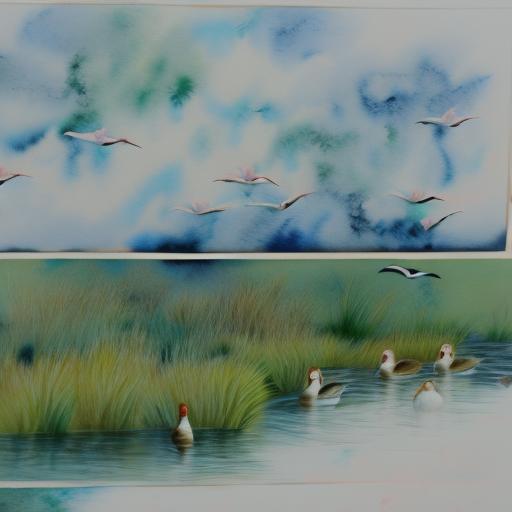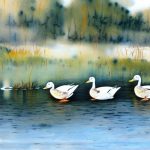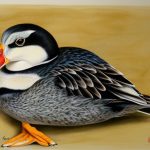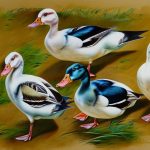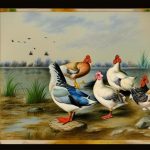Wild white duck breeds are a fascinating and beautiful group of waterfowl that have captured the attention of birdwatchers and conservationists alike. These stunning birds are known for their striking white plumage and graceful presence in their natural habitats. There are several species of wild white duck breeds, each with its own unique characteristics and behaviors. From the majestic white-winged duck to the elegant white-faced whistling duck, these birds are a sight to behold in the wild.
Wild white duck breeds are an important part of the ecosystem, playing a crucial role in maintaining the balance of their natural habitats. Their presence also adds to the aesthetic beauty of wetlands and water bodies where they can be found. As such, it is important to understand and appreciate these magnificent creatures and the role they play in the natural world. In this article, we will explore the characteristics, habitat, behavior, conservation efforts, and interactions with humans of wild white duck breeds, shedding light on these remarkable birds and the efforts being made to protect them.
Key Takeaways
- Wild white duck breeds are a diverse group of ducks found in various habitats around the world.
- These ducks are known for their distinctive white plumage and unique characteristics.
- Wild white duck breeds can be found in a wide range of habitats, from freshwater lakes and rivers to coastal marshes and wetlands.
- Their behavior and mating habits are fascinating to observe, as they engage in complex courtship displays and nesting behaviors.
- Conservation efforts are crucial for protecting wild white duck breeds and their habitats, as they face threats from habitat loss and human disturbance.
Characteristics of Wild White Duck Breeds
Wild white duck breeds are known for their striking white plumage, which sets them apart from other duck species. Their feathers are often a brilliant shade of white, with some species featuring subtle patterns or markings that add to their beauty. In addition to their stunning appearance, wild white duck breeds also have unique physical characteristics that make them well-adapted to their aquatic habitats. Many species have webbed feet that allow them to swim and navigate through water with ease, while their streamlined bodies and wings enable them to fly gracefully through the air.
These birds also have distinct beak shapes and sizes, which are adapted to their feeding habits and dietary preferences. For example, the white-faced whistling duck has a distinctive pink beak with a black tip, while the white-winged duck has a broad, flat bill that is well-suited for foraging in shallow waters. In terms of size, wild white duck breeds can vary significantly, with some species being relatively small and others reaching impressive sizes. Overall, these birds are not only visually stunning but also possess a range of physical adaptations that make them well-suited to their natural environments.
Habitat and Distribution of Wild White Duck Breeds
Wild white duck breeds can be found in a variety of habitats across the globe, from freshwater wetlands and marshes to coastal estuaries and rivers. Their distribution is often influenced by factors such as food availability, water quality, and nesting sites. Some species, such as the white-winged duck, are primarily found in dense tropical forests near rivers and streams, while others, like the white-faced whistling duck, are more commonly seen in open wetlands and grassy marshes.
These birds are also known for their migratory behavior, with many species undertaking long-distance journeys between breeding and wintering grounds. This means that wild white duck breeds can be found in a wide range of geographical locations throughout the year, making them a diverse and adaptable group of birds. Their ability to thrive in different habitats and climates speaks to their resilience and adaptability as a species. However, despite their ability to inhabit various environments, wild white duck breeds face numerous threats to their habitats, including habitat loss, pollution, and climate change.
Behavior and Mating Habits of Wild White Duck Breeds
Wild white duck breeds exhibit a range of fascinating behaviors and mating habits that are essential to their survival and reproductive success. These birds are often social creatures, forming large flocks during migration or congregating in groups at feeding and roosting sites. Some species are known for their distinctive vocalizations, such as the whistling calls of the white-faced whistling duck or the soft cooing sounds of the white-winged duck.
During the breeding season, wild white duck breeds engage in courtship displays and rituals to attract mates. These displays can include elaborate movements, vocalizations, and plumage displays designed to impress potential partners. Once a pair bond is formed, the birds will often build nests in secluded areas near water, using materials such as grasses, reeds, and down feathers. The female will then lay a clutch of eggs, which she will incubate until they hatch.
After hatching, the ducklings are cared for by both parents and will remain with them until they are old enough to fend for themselves. This period of parental care is crucial for the survival of the young birds, as they learn essential skills such as foraging, swimming, and avoiding predators from their parents. Overall, the behavior and mating habits of wild white duck breeds are complex and fascinating, reflecting the intricate social dynamics and reproductive strategies of these remarkable birds.
Conservation Efforts for Wild White Duck Breeds
Conservation efforts for wild white duck breeds are essential for ensuring the long-term survival of these magnificent birds. Many species of wild white duck breeds are facing significant threats to their populations, including habitat loss, hunting pressure, pollution, and climate change. As a result, numerous organizations and conservation groups are working tirelessly to protect these birds and their habitats through a variety of initiatives.
One key aspect of conservation efforts for wild white duck breeds is habitat protection and restoration. This involves identifying important breeding and feeding areas for these birds and implementing measures to safeguard these critical habitats from development or degradation. Wetland conservation is particularly important for many species of wild white duck breeds, as these areas provide essential resources such as food, nesting sites, and shelter.
In addition to habitat conservation, efforts are also being made to address other threats facing wild white duck breeds. This includes advocating for sustainable hunting practices, reducing pollution in waterways, and raising awareness about the importance of these birds and their habitats. Research and monitoring programs are also crucial for gathering data on population trends, behavior, and ecology of wild white duck breeds, which can inform conservation strategies and management decisions.
Interactions with Humans and Domestic Ducks
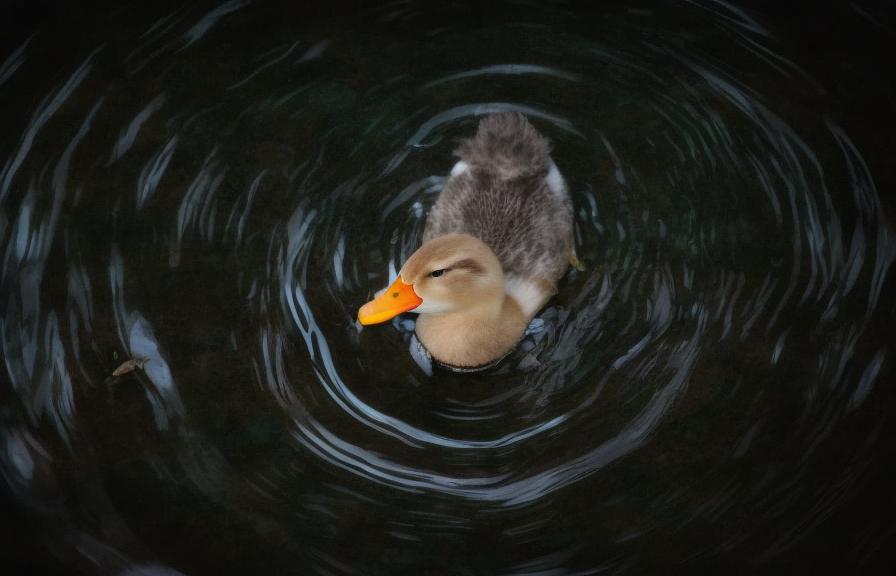
Wild white duck breeds have complex interactions with humans and domestic ducks that can have both positive and negative impacts on their populations. These birds are often admired by birdwatchers and nature enthusiasts for their beauty and grace, making them a popular subject for wildlife photography and ecotourism. However, human activities can also pose significant threats to wild white duck breeds, such as habitat destruction, pollution, disturbance at nesting sites, and hunting pressure.
In addition to interactions with humans, wild white duck breeds can also come into contact with domestic ducks in certain situations. This can lead to hybridization between wild and domestic ducks, which can have negative consequences for the genetic integrity of wild populations. In some cases, escaped or released domestic ducks may compete with wild white duck breeds for resources or introduce diseases that can impact wild populations.
Efforts to mitigate these interactions include promoting responsible birdwatching practices that minimize disturbance to wild white duck breeds and their habitats. Additionally, measures such as controlling the release of domestic ducks into the wild and managing feral populations can help reduce the potential negative impacts on wild populations. By understanding these interactions and implementing appropriate management strategies, it is possible to minimize human-induced threats to wild white duck breeds.
Popular Wild White Duck Breeds for Birdwatching
For birdwatchers and nature enthusiasts, observing wild white duck breeds in their natural habitats is a rewarding experience that offers a glimpse into the beauty and diversity of these remarkable birds. Several species of wild white duck breeds are particularly popular among birdwatchers due to their striking appearance and interesting behaviors. One such species is the white-faced whistling duck (Dendrocygna viduata), known for its distinctive whistling calls and striking black-and-white facial markings.
Another popular wild white duck breed for birdwatching is the smew (Mergellus albellus), a small diving duck with striking black-and-white plumage that is often seen in northern Europe during the winter months. The smew’s elegant appearance and elusive nature make it a sought-after sight for birdwatchers looking to add this species to their life list. Additionally, the white-winged duck (Asarcornis scutulata) is a highly sought-after species for birdwatchers due to its rarity and stunning appearance.
Overall, wild white duck breeds offer birdwatchers an opportunity to observe these beautiful birds in their natural habitats while learning about their behavior and ecology. By promoting responsible birdwatching practices and supporting conservation efforts for these birds, it is possible to ensure that future generations can continue to enjoy the beauty of wild white duck breeds in the wild.
If you’re interested in learning more about wild white duck breeds, you might also want to check out this article on large chicken coop ideas on PoultryWizard. Creating a suitable environment for your ducks or chickens is essential for their well-being, and this article provides valuable insights into designing and building a spacious and comfortable coop. Whether you’re considering a Hannah Montana-themed coop or looking for chicken coop run plans, PoultryWizard has a wealth of resources to help you create the perfect space for your feathered friends. (source)
FAQs
What are wild white duck breeds?
Wild white duck breeds are species of ducks that have white plumage and are found in their natural habitats. These ducks are not domesticated and live in the wild.
Where are wild white duck breeds found?
Wild white duck breeds can be found in various regions around the world, including North America, Europe, Asia, and Australia. They inhabit freshwater lakes, rivers, marshes, and other wetland areas.
What are some examples of wild white duck breeds?
Some examples of wild white duck breeds include the Pekin duck, the Mallard, the White Crested duck, and the Aylesbury duck. These ducks are known for their distinctive white plumage.
What do wild white duck breeds eat?
Wild white duck breeds primarily feed on a diet of aquatic plants, insects, small fish, and other aquatic organisms. They are omnivorous and will also consume grains and seeds found in their natural habitat.
Are wild white duck breeds endangered?
The conservation status of wild white duck breeds varies depending on the specific species and their geographic location. While some populations may be stable, others may be threatened by habitat loss, pollution, and hunting. Conservation efforts are in place to protect these species and their habitats.
Meet Walter, the feathered-friend fanatic of Florida! Nestled in the sunshine state, Walter struts through life with his feathered companions, clucking his way to happiness. With a coop that’s fancier than a five-star hotel, he’s the Don Juan of the chicken world. When he’s not teaching his hens to do the cha-cha, you’ll find him in a heated debate with his prized rooster, Sir Clucks-a-Lot. Walter’s poultry passion is no yolk; he’s the sunny-side-up guy you never knew you needed in your flock of friends!

